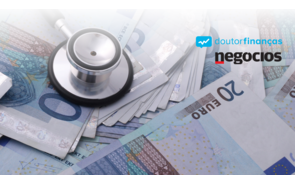É a FED que está por trás da subida dos mercados ?
3 mensagens
|Página 1 de 1
A compra de activos por parte da Fed é um facto.
Tudo o resto é bola de neve.
Permanent OMOs: Treasury
The purchase or sale of Treasury securities on an outright basis adds or drains reserves available in the banking system. Such transactions are arranged on a routine basis to offset other changes in the Federal Reserve’s balance sheet in conjunction with efforts to maintain conditions in the market for reserves consistent with the federal funds target rate set by the Federal Open Market Committee (FOMC).
On March 18, 2009, the FOMC announced a longer-dated Treasury purchase program with a different operating goal, to help improve conditions in private credit markets.
On August 10, 2010, the FOMC directed the Open Market Trading Desk at the Federal Reserve Bank of New York to keep constant the Federal Reserve’s holdings of securities at their current level by reinvesting principal payments from agency debt and agency mortgage-backed securities in longer-term Treasury securities.
On November 3, 2010, the FOMC decided to expand the Federal Reserve's holdings of securities in the SOMA to promote a stronger pace of economic recovery and to help ensure that inflation, over time, is at levels consistent with its mandate.
Como gosta de gráficos veja lá se o minimo não foi a 9 de Março.
http://www.newyorkfed.org/markets/pomo/ ... /index.cfm
Tudo o resto é bola de neve.
Permanent OMOs: Treasury
The purchase or sale of Treasury securities on an outright basis adds or drains reserves available in the banking system. Such transactions are arranged on a routine basis to offset other changes in the Federal Reserve’s balance sheet in conjunction with efforts to maintain conditions in the market for reserves consistent with the federal funds target rate set by the Federal Open Market Committee (FOMC).
On March 18, 2009, the FOMC announced a longer-dated Treasury purchase program with a different operating goal, to help improve conditions in private credit markets.
On August 10, 2010, the FOMC directed the Open Market Trading Desk at the Federal Reserve Bank of New York to keep constant the Federal Reserve’s holdings of securities at their current level by reinvesting principal payments from agency debt and agency mortgage-backed securities in longer-term Treasury securities.
On November 3, 2010, the FOMC decided to expand the Federal Reserve's holdings of securities in the SOMA to promote a stronger pace of economic recovery and to help ensure that inflation, over time, is at levels consistent with its mandate.
Como gosta de gráficos veja lá se o minimo não foi a 9 de Março.
http://www.newyorkfed.org/markets/pomo/ ... /index.cfm
"Não perguntes a um escravo se quer ser livre".Samora Machel
http://www.nationmultimedia.com/2010/01 ... 119895.php
Is the Fed acting behind the US stock market rally?
"It's a slow day in a little east Texas town. The sun is beating down, the streets are deserted. Times are tough, everybody is in debt, and everybody lives on credit.
On this particular day, a rich tourist from the East Coast is driving through town. He stops at the motel and lays a US$100 bill on the desk, saying he wants to inspect the rooms upstairs in order to pick one to spend the night.
As soon as the man walks upstairs, the owner grabs the bill and runs next door to pay his debt to the butcher. The butcher takes the $100 and runs down the street to retire his debt to the pig farmer. The pig farmer takes the $100 and heads off to pay his bill at the supplier of feed and fuel. The guy at the farmers' co-op takes the $100 and runs to pay his debt to the local prostitute, who has also been facing hard times and has had to offer her services on credit.
The hooker rushes to the hotel and pays off her room bill to the hotel owner. The hotel proprietor then places the $100 back on the counter so the rich traveller will not suspect anything.
At that moment, the traveller comes down the stairs, picks up the $100 bill, states that the rooms are not satisfactory, pockets the money, and leaves town.
No one produced anything. No one earned anything. However, the whole town is now out of debt and now looks to the future with a lot more optimism. And that, ladies and gentlemen, is how governments are conducting business today."
This story is cynical, but it really hits the point. After the economic bubble burst, the US government is now scrambling to clean up the mess. The US Federal Reserve has already committed $8.2 trillion to bail out the financial system, as well as corporate debts. The US's annual gross domestic product is about $14.2 trillion.
Sprott Asset Management, a Toronto-based hedge fund, has recently cast doubt that the US government is coming clean on its bail-out. In fiscal year 2009, the US added another $1.88 trillion to its public debt, which had to be financed by the US Treasury issuing securities. The foreign and international buyers purchased $697.5 billion of US treasuries; the Federal Reserve, which is pursuing an aggressive money printing policy, $286 billion; and the household sector $704 billion.
But Sprott Asset suspects that something fishy is going on. For the household sector was loosely defined, and it does not seem that any parties, under the current economic conditions, have $704 billion to buy into US treasuries. It concluded that the real buyer behind the household sector was none other than the US Federal Reserve itself.
If that were to be the case, the Fed would have already become the major financier of the US deficit to the tune of $1 trillion. Since next year the US deficit will reach more than $2.2 trillion, we can expect the Fed to continue printing money to finance the massive US overspending.
Charles Biderman, CEO of TrimTabs, also suspects that the US Federal Reserve is behind the stock market rally since March 2009 (see http://www.zerohedge.com/article/trimta ... uggestions.) Ever since, US stocks have soared by more than $6 trillion.
Biderman went through the list of traditional players in the US stock market. He found that US corporations were net sellers of equities. US retail investor funds were hardly buying equities. US retail investors were also not buying equities directly in any significant amount. Foreign investors were net buyers of US stocks at around $109 billion between April and October 2009. Hedge funds posted net outflow of $12 billion from April to November 2009. Pension funds were not making asset allocations.
Then who is the buyer behind the US stock market rally? The money must come from somewhere.
Biderman pointed out that the US Treasury and US Fed have been bailing out US banks and corporations in a desperate attempt to save the US economy. So it will not come as a surprise that may also have entered the stock market to boost US equities.
"We want to emphasize that we have no evidence that the Fed or the Treasury are throwing money into the stock market, either directly or indirectly. But if they are not pumping up stock prices, then who is?" he wrote.
If this is the case, then the whole US market is now rigged, with the Fed bailing out everything from banks, corporations, US Treasuries and US stocks.
The US Federal Reserve is not subject to any independent audit. So nobody is in a position to know its exact balance sheet. For now, the Fed has made some Americans happy, but the question is, what's next?
- Mensagens: 1315
- Registado: 27/5/2010 18:17
- Localização: Lisboa
É a FED que está por trás da subida dos mercados ?
Algumas teorias apontam a FED (Reserva Federal dos Estados Unidos da América) como a principal autora ou «autora moral» da compra de acções, ETFs, Futuros?
Qual a vossa opinião sobe isso?
Qual a vossa opinião sobe isso?
- Mensagens: 1315
- Registado: 27/5/2010 18:17
- Localização: Lisboa
3 mensagens
|Página 1 de 1
Quem está ligado:
Utilizadores a ver este Fórum: carlosdsousa, fmsanjau, Google [Bot], m-m, navaldoc, PMP69 e 25 visitantes


